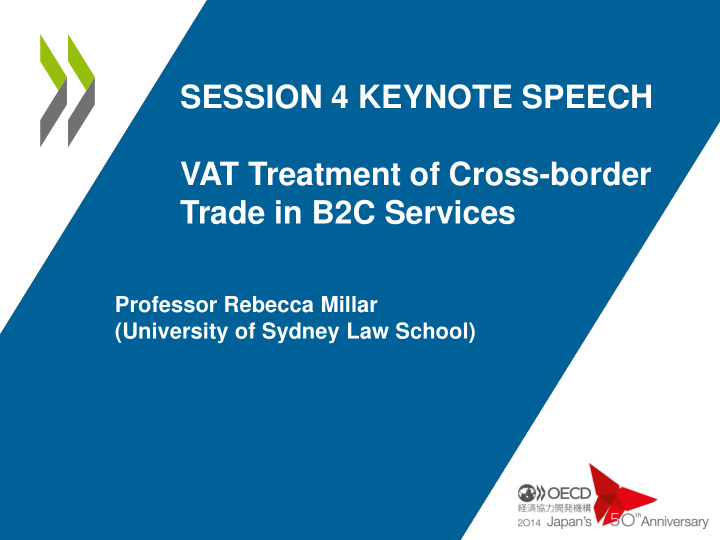



SESSION 4 KEYNOTE SPEECH VAT Treatment of Cross-border Trade in B2C Services Professor Rebecca Millar (University of Sydney Law School) 1
My brief: 1. Overview of existing models. 2. ‘Have a go’ at identifying common principles/approaches. 3. Consider emerging conclusions of WP9. 4. Ideas on how to advance the work on B2C guidelines to meet countries’ expectations. 2
E XISTING M ODELS FOR A PPLYING VAT TO C ROSS -B ORDER T RADE IN S ERVICES 3
Legal design approaches Two main models for implementing ‘place of taxation’ rules in a VAT law. Categorisation: ➙ sub-categorise services ➙ specify place of taxation for each category ➙ usually one step: place of supply = place of taxation e.g. EU VAT Directive & EU Member States ➙ specific rules for 14 or 15 different groups of services (some B2B, some B2C, some both) ➙ a general rule for all other B2C services: proxy = supplier location 4
Legal design approaches Two main models for implementing ‘place of taxation’ rules in a VAT law. Iterative (principle-based): ➙ systematically applies a series of proxies for place of consumption to all kinds of services ➙ limited or no sub-categorisation ➙ e.g. Australia, New Zealand, Singapore, South Africa Bangladesh, Botswana, IMF models Hybrids: ➙ Many VAT/GST laws include both categorisation and iterative elements 5
Iterative Approach Explained Step 1: Place of supply supplier’s place of business (Singapore; Botswana; South Africa) plus place of performance (NZ) plus right or option to acquire something in the jurisdiction (Aus) ‘Place of supply’ rule makes a preliminary assertion of jurisdiction to tax (the right to tax) on the basis of enforcement jurisdiction + expectation of co-location 6
Iterative Approach Explained Step 2: Adjust to match destination-based substantive jurisdiction Outbound (if place of supply = jurisdiction) • zero-rate • place of taxation refers to multiple proxies • connection with tangible property (land/goods outside) or absence of connection with local tangible property • customer location and/or residence • location of other person to whom the services are delivered • place where ‘for use’, place of effective use or enjoyment… Inbound (if place of supply ≠ jurisdiction) • taxed on ‘import’ • main proxy = customer residence (e.g. NZ reverse charge) 7
EU General & Specific Rules Consider EU list of categories from Session E • 13 categories of services • All or part of 5 of the categories are not treated as services in Australia & New Zealand: – immoveable property; – short and long term hire of means of transport; – restaurant services, whether on-board or not. • Of the other 8, only 2 =(partly) subject to special rules – international transport of goods & passengers; – telecommunications (global roaming) • Even where there are special rules, it is not possible to specify a single proxy that relates to each EU category 8
Consequences? • Consider Session E case study • Reminder of the facts of the case study 9
Service Taxing rights (EU) Taxing rights (NZ) Taxing rights (Aus) Country B Country B Country B (Non-resident reseller ① Hotel (residence of customer (residence of customer exclusions from irrelevant) irrelevant: but on what value?) registration threshold) Country B Country B Country B ② Car repair (also taxable for non- (residence of supplier & (also taxable for non-residents) residents) customer irrelevant) Country B Country B Country B ③ Restaurant (also taxable for non- (residence of supplier & (also taxable for non-residents) residents) customer irrelevant) Country B Country B Country B ④ Hotel Wi-Fi (also taxable for non- (residence of customer (also taxable for non-residents) residents) irrelevant) Country A Not Country B Not Country B ⑤ Download of ( not taxable for non- ( Movie streamed in NZ by (Consumed in Aust but digital movie residents ) non-resident from non-resident) no tax collected) Country A Country B Country B ⑥ International phone call - global ( not taxable for non- (Non-res. supplier exclusions (Consumed in Aus but not 10 roaming residents ) from registration threshold) taxed under special rule)
W HERE DO WE GO FROM HERE ? 11
Broad categories of situations WP9 Nov 2013 TAG Task Teams Apr 2014 Services relating to immoveable property Services relating to tangible property Services relating to tangible moveable property Non-remote services Non-remote services Remote services: digital Remote services: Remote services: other 12
Recommend
More recommend